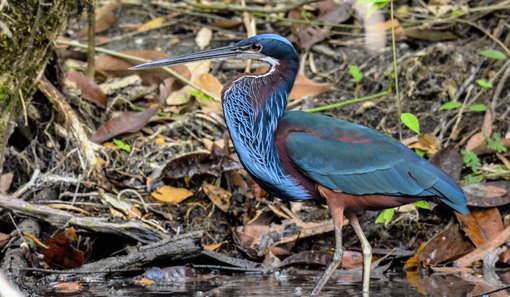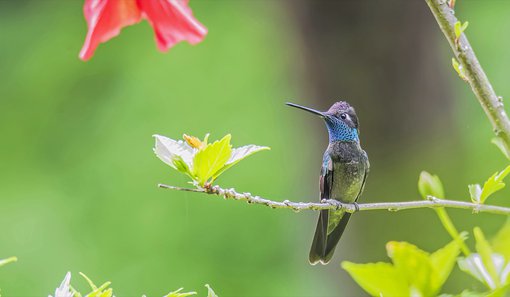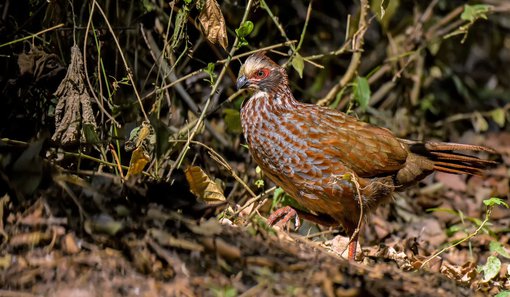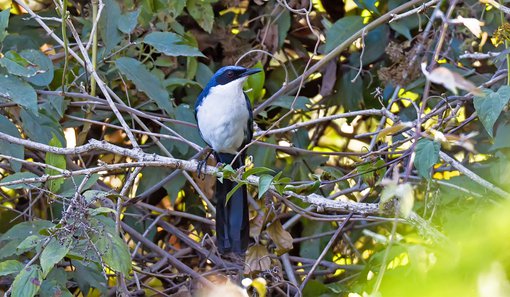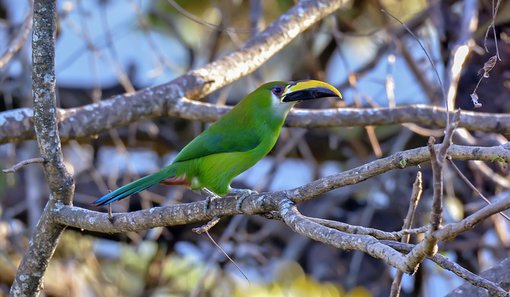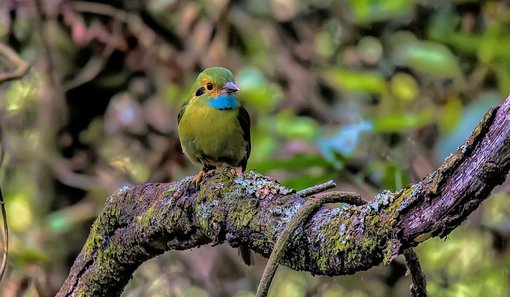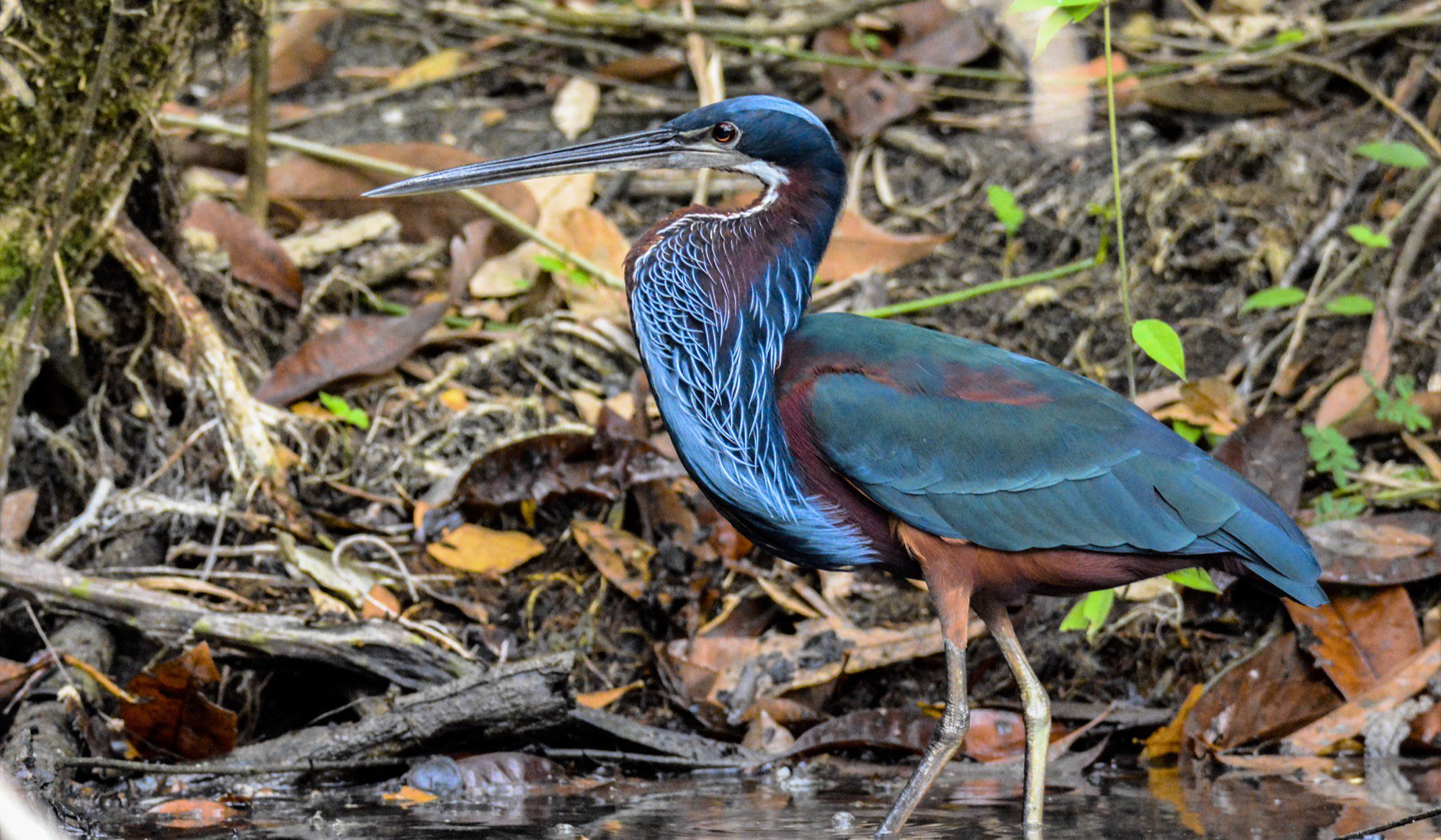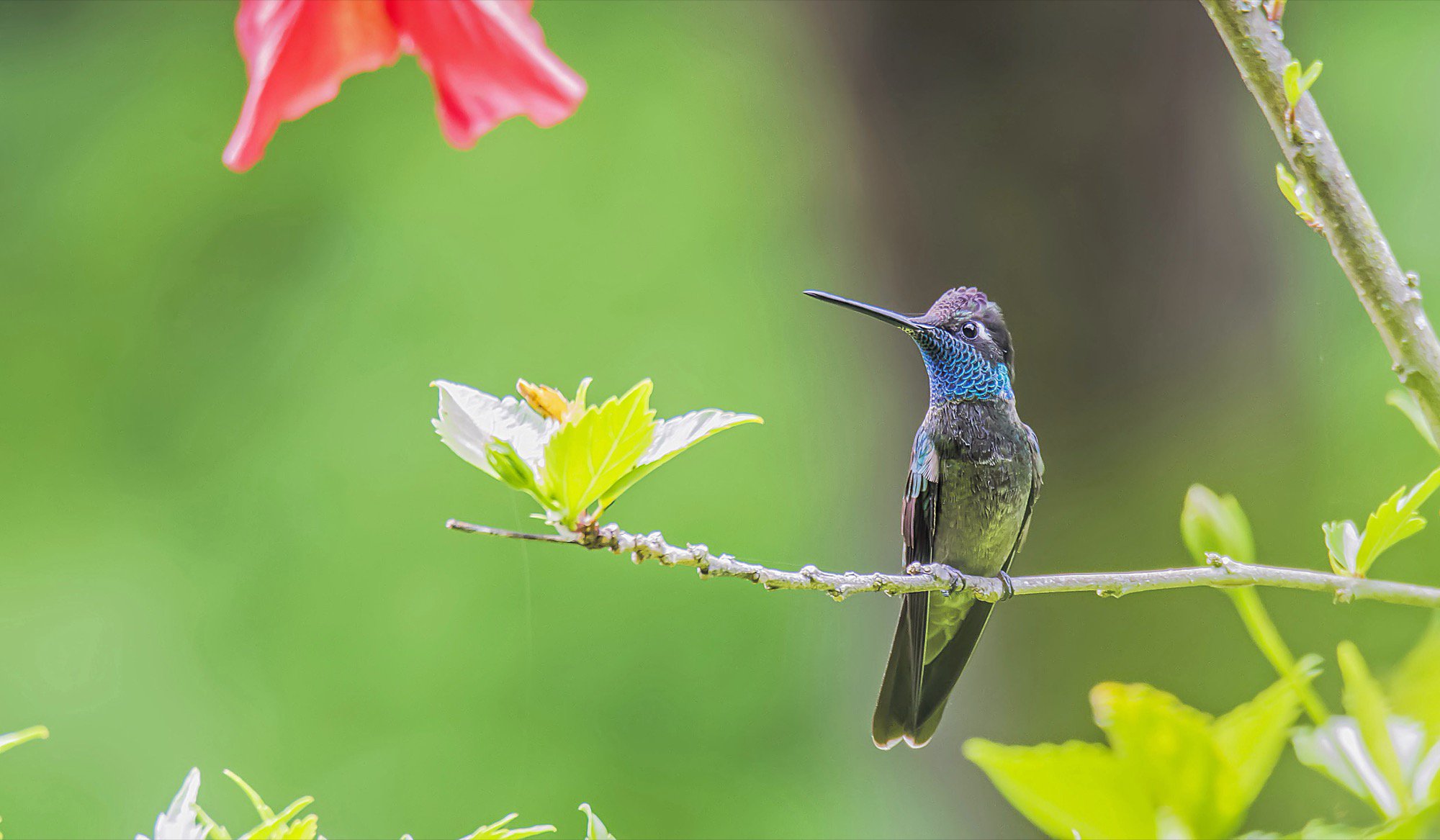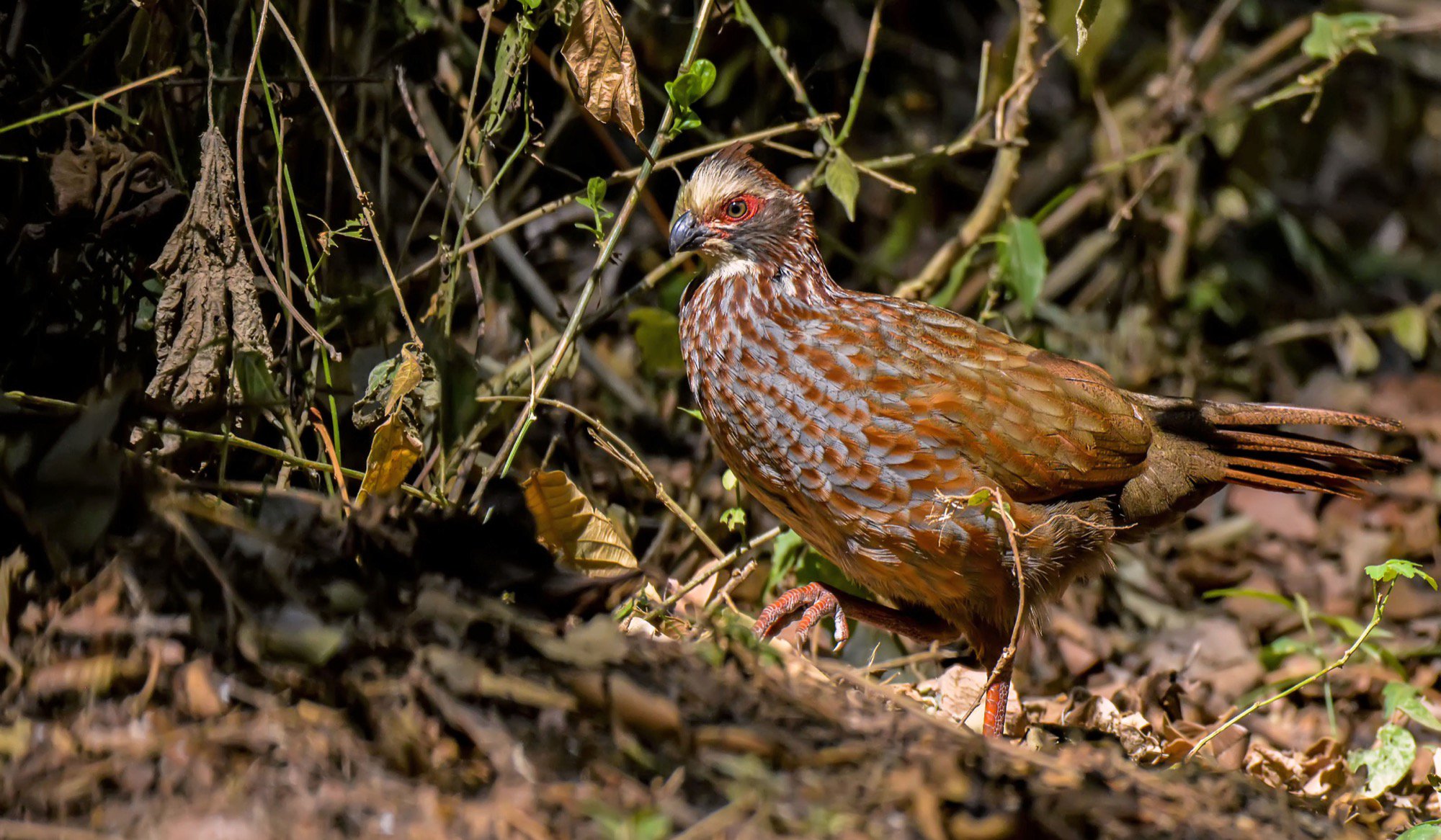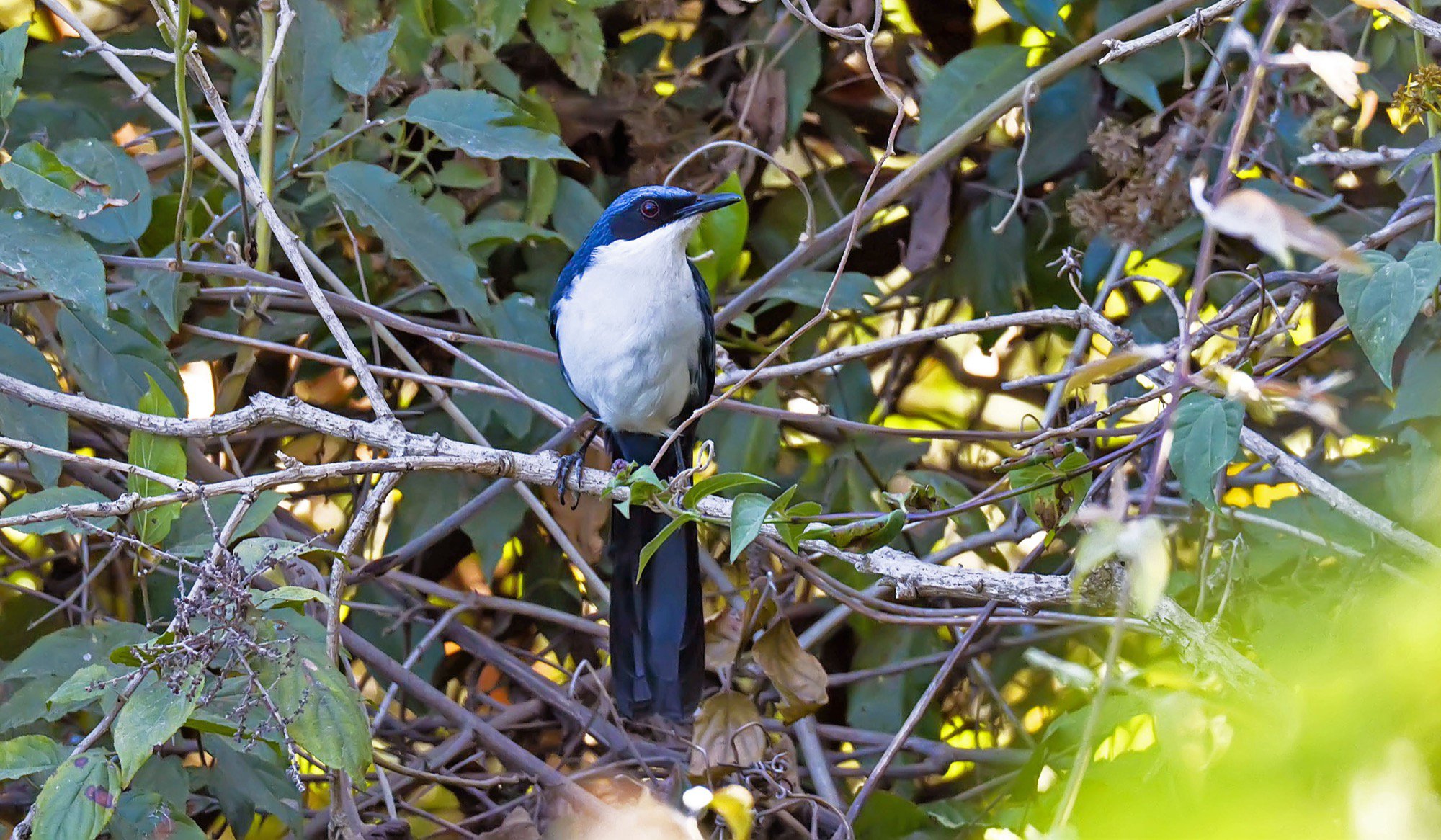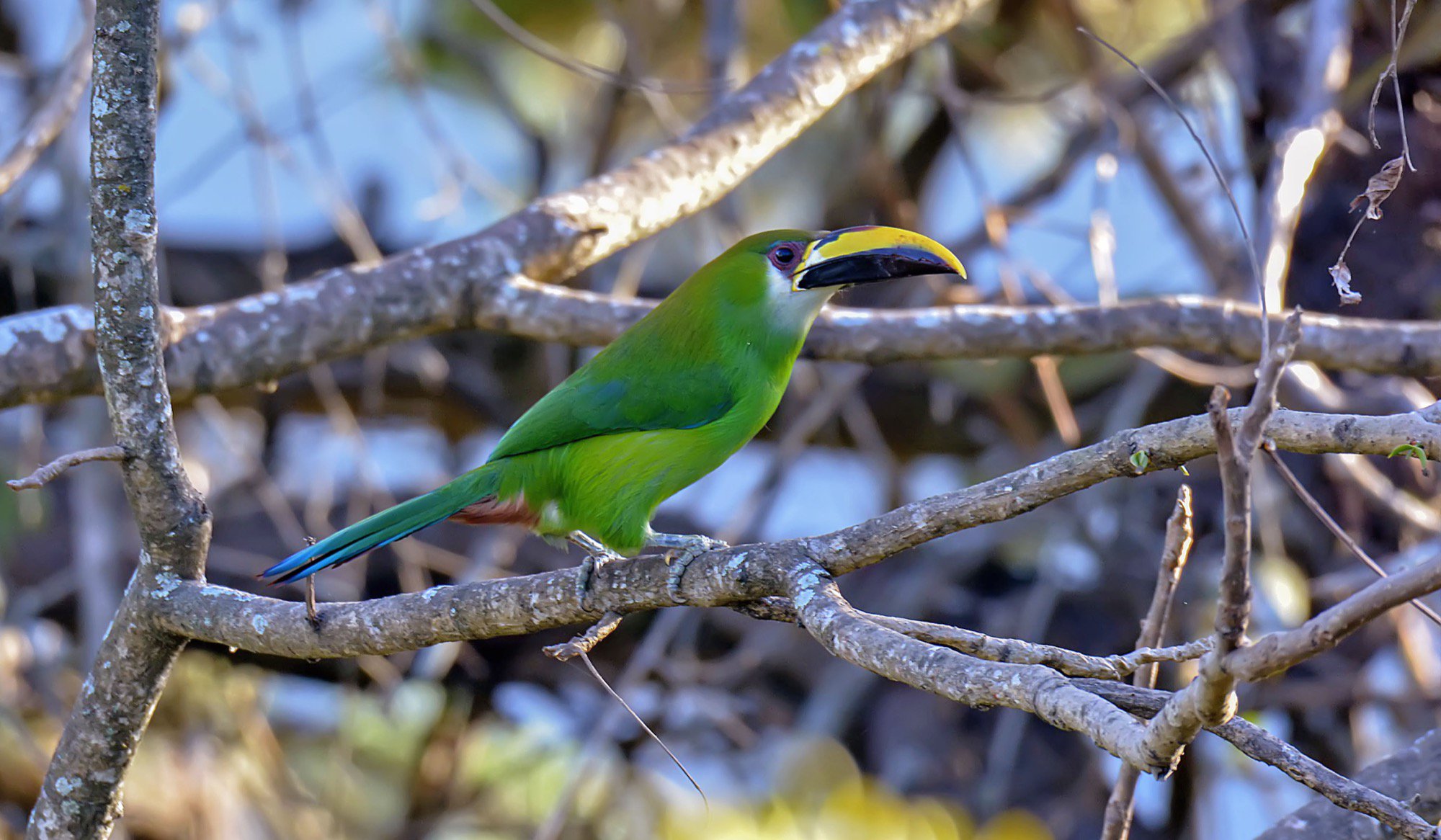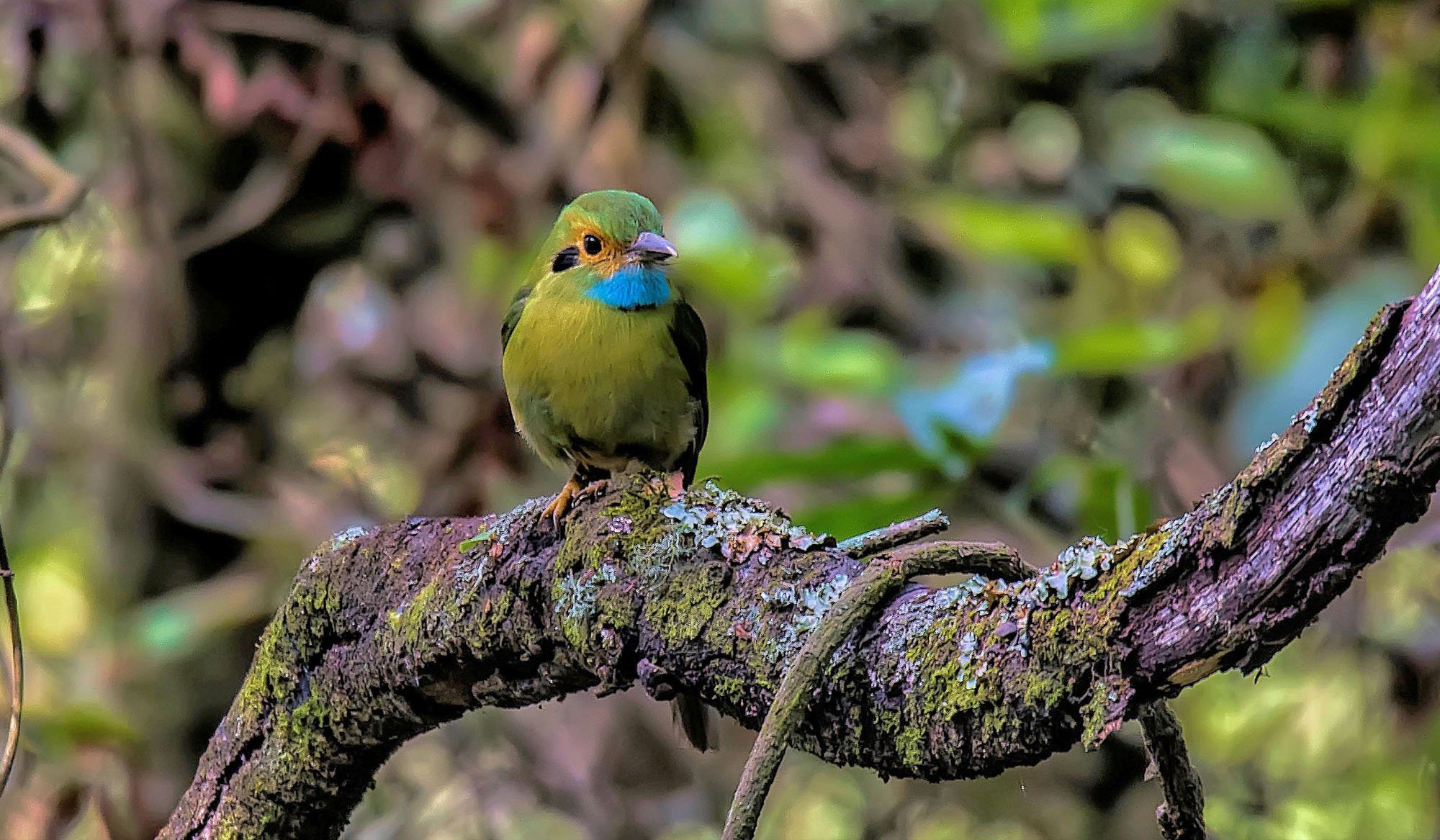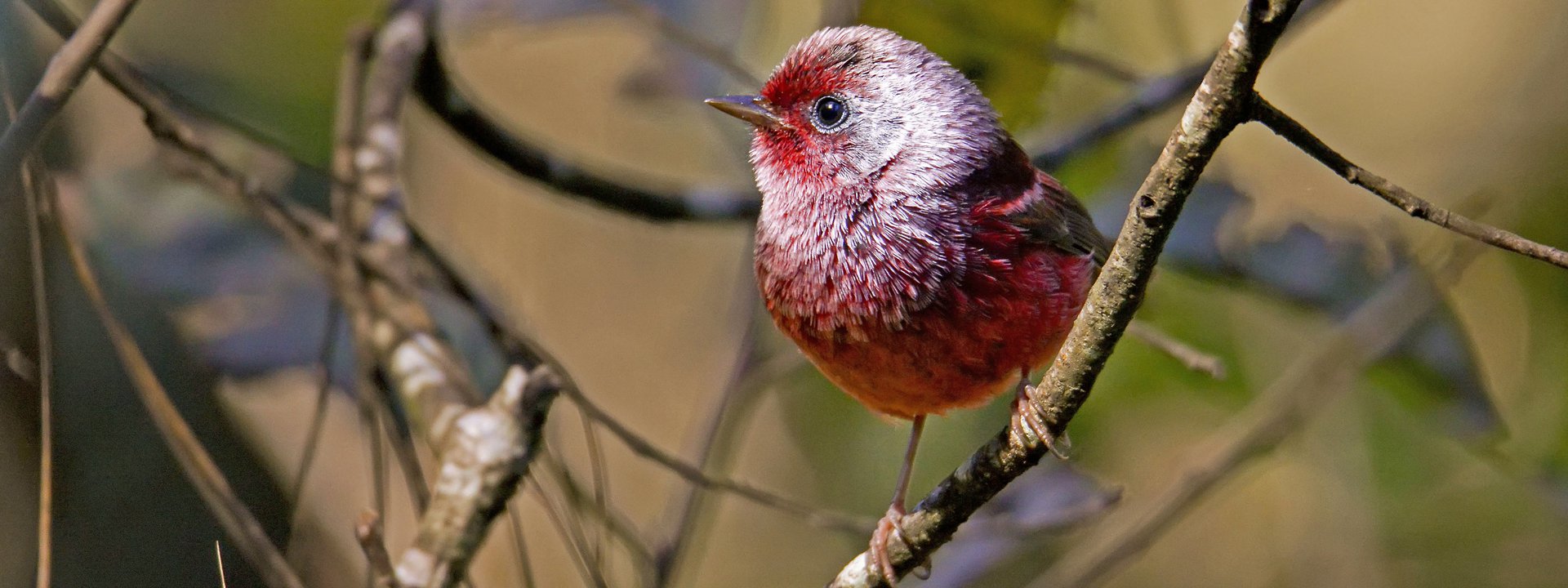Guatemala
Highlands and Horned Guans
A 13-day, small group birdwatching tour to Guatemala with an optional excursion to the UNESCO World Heritage Site at Tikal
Guatemala has many unique attractions, however, it says something about a country when even its currency is named after a bird - the exquisite Resplendent Quetzal! Indeed, as a birdwatching destination, this beautiful and incredibly scenic Central American country is right up there with the best of them.
Our Guatemala birding tour focuses mainly on the central highlands, to the west of Guatemala City, visiting the best locations and lodges for a wonderful range of speciality birds.
Join our quest for the enigmatic Horned Guan, revered Resplendent Quetzal, fabulous Pink-headed and Goldman's Warblers and rare Azure-rumped Tanager, plus a carnival of colourful hummingbirds and tanagers.
There is also the option of an extension to the lowlands which includes a visit to the UNESCO World Heritage Site of Tikal where we will visit one of the most famous archaeological sites in the Americas. Here, we will see the internationally famous temples and palaces of the Mayan people which are surrounded by forest and enjoy more great birding.
Tour Dates & Prices
Thu 20th February 2025
Tue 4th March 2025
- Available
Tour Cost: 13 Days from £4195
What's Included?
- Limosa Tour Leader
- Expert English-speaking Guatemalan bird guide
- 11 nights accommodation in Guatemala, staying at comfortable hotels, lodges and fincas
- All main meals and drinking water provided
- Travel by comfortable minibus with local driver, switching to 4WD vehicle where necessary
- Boat transfers on Lake Atitlan
- All excursions, local guides, permits, entry fees
- All tour-based tips (lodges, drivers and local guides) and taxes
- Limosa checklist of birds
Cost Excludes
Flights, insurance, drinks, airport snacks/meals and other items of a personal nature
Notes
For full details and prices for our extension to Tikal and Las Guacamayas Biological Station please see the bottom of the 'Itinerary' tab.
The Land Only Tour Cost is the amount you will pay Limosa.
Despite the end of pandemic restrictions, we have taken the decision to continue to price our holidays as excluding international flights.
To keep the process as simple as possible, we are working very closely with a dedicated agent at Travel Counsellors, Sacha Barbato, who is essentially now our “in house” flight consultant.
Sacha is a highly experienced independent ATOL bonded travel agent, and his contact details are as follows: sacha.barbato@travelcounsellors.com and 01603 360099
He will be able to advise you which flights we are recommending for each holiday and will be able to book these for you.
This will also sometimes give you the option to travel from a regional airport if you prefer.
Tour Highlights
- Beautiful and immensely scenic Central American country that is bursting with great birding
- Possibilities include multiple specialities such as Horned Guan, Pink-headed Warbler, Goldman's Warbler, Blue-and-white Mockingbird and Resplendent Quetzal
- A host of hummingbirds, wintering North American warblers and colourful rainforest tanagers
- Other birds we hope to see include Rufous Sabrewing, Tody Motmot, Bushy-crested Jay, Hooded Grosbeak, Golden-cheeked Warbler and Azure-rumped Tanager
- Visit to Lake Atitlan at 5,100 feet, which is ringed by volcanoes and sometimes described as the world's most beautiful lake
- Comfortable and characterful lodgings, with friendly people, good food and great coffee
- An optional extension to Tikal and Las Guacamayas Biological Station offering not only chances of some fantastic additional birds (eg Scarlet Macaw, Agami Heron, Yucatan Woodpecker, Rose-throated Tanager and Lovely Cotinga) but also an opportunity to visit one of the most famous and important archaeological sites in the Americas
- Small group tour - maximum 8 participants
- Expertly led by Limosa’s Fernando Enrique Navarrete and resident Guatemalan naturalist guides
Outline Itinerary
Fly to Guatemala City and transfer to our hotel in colonial Antigua. Antigua (2 nights)
Birding at Finca el Pilar, near Antigua
Morning at Rincón Suizo forest. After breakfast and birding at Tecpan drive to Huehuetenango. Night at Ruinas Resort
Visit to Parque Todos Santos for the near-endemic Goldman’s Warbler and many other specialities. Afternoon transfer to Zunil Quetzaltenango. Night at Las Cumbres.
Fuentes Georginas for Horned Guan and many other species. Afternoon transfer to Los Tarrales for 2 nights.
Full day at Los Tarrales.
Transfer to Lake Atitlán and next morning seek Horned Guan on Volcan San Pedro. Hotel Bambu, Santiago Atitlan (2 nights).
Leave Lake Atitlan and travel east to the arid Motagua Valley. Night Camino Largo.
Birding in the Motagua scrublands. Look for Golden-cheeked Warbler at Rio Escondido. Next day at Biotopo del Quetzal and Ranchitos del Quetzal reserves. Ram Tzul Lodge (2 nights).
Morning Biotopo del Quetzal, return to Guatemala City. Fly to UK.
Afternoon arrival in UK
______________________________
Early evening flight from Guatemala City to Flores. Lakeside hotel in Flores (1 night)
Transfer to Las Guacamayas Biological Station (2 nights)
Full day at Las Guacamayas Biological Station
We have a final morning at Las Guacamayas Biological Station and then transfer to Tikal. Jungle Lodge, Tikal (2 nights)
A full day at Tikal National Park which is a UNESCO World Heritage Site
A final early morning at Tikal. Transfer to Flores, fly to Guatemala City. Fly to UK
Afternoon arrival in UK

Guatemala is a beautiful Central American country with a great deal to offer the visitor as the birds are brilliant, colourful and diverse. From the fabulous bright green-and-red Resplendent Quetzal to the fantastic Pink-headed Warbler and rare Horned Guan, there is plenty to see and now with newly discovered populations of the guan offering much easier access than before, this tour offers an amazing opportunity to explore this relatively compact country.
Our exciting 13-day holiday begins in Guatemala City and focuses mainly on the species-rich highlands of the Pacific Slope to the west. We will explore cool, high-elevation pine-oak forests, a spectacular volcanic lake ringed by volcanoes, shade-grown coffee plantations, hot, dry thorn-forest and temperate cloudforests - all of which have their own unique set of special birds.
Our birding begins around the old Spanish colonial city of Antigua, with a visit to some superb hummingbird feeders. The regionally endemic Green-throated Mountaingem, recently split Rivoli’s Hummingbird and localised Rufous Sabrewing (endemic to the mountains of the Pacific Slope) are among many which we hope to find.
In the upper reaches of the pine-oak and cloud forests, the trees can be full of birds: everything from Grey Silky-flycatchers to Rufous-collared Thrushes, while more difficult-to-find specialities include the spectacular Mountain Trogon and striking Hooded Grosbeak.
In Parque Todos Santos we shall spend a day in search of the near-endemic and stunning Goldman's Warbler.
Each hill we visit seems to have its own subtly different avifauna. Sought-after regional highland specialities include the fabulous Pink-headed Warbler which is unquestionably one of the star birds on this tour, however, we also hope to find Rufous-browed Wren, Blue-throated Motmot and Black-capped Siskin, all of which have restricted distributions. There will also be a fantastic range of colourful Nearctic migrants to enjoy, with Townsend's, Hermit and Red-faced Warblers all possible, alongside the resident Slate-throated Redstart and Crescent-chested and Olive Warblers.
Horned Guan is another of our key 'target species' and we have a couple of chances to find this endangered and highly localised bird. As big as a turkey, the adult male Horned Guan is notable for the scarlet ‘horn’ which projects straight up from its crown. This species was once legendary for the difficulty in finding it in the cloudforests but a new population has recently been discovered at a more easily accessible site and we have our fingers crossed to repeat the success of our last tour!
In Guatemala, the diversity of montane birding is such that every day can bring new species with Crested Guan, White-bellied Chachalaca, Long-tailed Manakin, Tody Motmot, Rufous-breasted Spinetail, the rare Azure-rumped Tanager, Prevost's (White-faced) Ground Sparrow amongst the possibilities.
Rounding off an exciting tour, we travel back east, beyond Guatemala City, to the arid Motagua Valley offers a contrasting avifauna to the moist cloudforests. Motagua is the hottest and driest region of Guatemala and the dry forest here is both very different to anything else we will see on our tour and complete with its own special birds. The superb Turquoise-browed Motmot is one of the most conspicuous residents and Cinnamon Hummingbird, White-throated Magpie-Jay and Rufous-naped Wren also occur in the valley.
For our ‘grand finale’ we visit La Reserva del Quetzal, seeking the smart Azure-hooded Jay, Chestnut-headed Oropendola and, of course, the exquisite Resplendent Quetzal which is widely regarded as one of the world's most beautiful birds. We also have a chance of finding the rare Golden-cheeked Warbler, a migrant which is an endemic breeder to Texas and passes the winter here.
All in all, Guatemala is a fabulous birding destination, offering much improved accommodation and tourist infrastructure, a rich cultural heritage, fine landscapes and a wealth of special birds and some of the best coffee in the world to wake up to! Our February tour combines all this to bring you a memorable Central American holiday, one that is jam-packed with exciting and very special birds.
For those wanting to maximise on their Guatemala experience, we are now offering an exciting extension to the lowlands which includes a visit to one of the most important archaeological sites in the Americas, the remarkable palaces and temples at the UNESCO World Heritage Site of Tikal. With many of the monuments located in the midst of luxuriant forest, this gives us a fantastic opportunity to combine birdwatching with enjoying the amazing archaeology.
With two nights also included at the comfortable Las Guacamayas Biological Station for even more special species (eg Yucatan Woodpecker, Yucatan Poorwill and Rose-throated Tanager), the extension offers an incredible extra few days to complement the main tour.
Our 2025 holiday will again be led by Limosa guide Fernando Enrique Navarrete, returning for his 11th visit to Guatemala. Fernando is a fluent English and Spanish-speaker and, having also studied birds in Guatemala and neighbouring Belize, his love and enthusiasm for this beautiful country and its brilliant birds and wildlife is sure to inspire you!
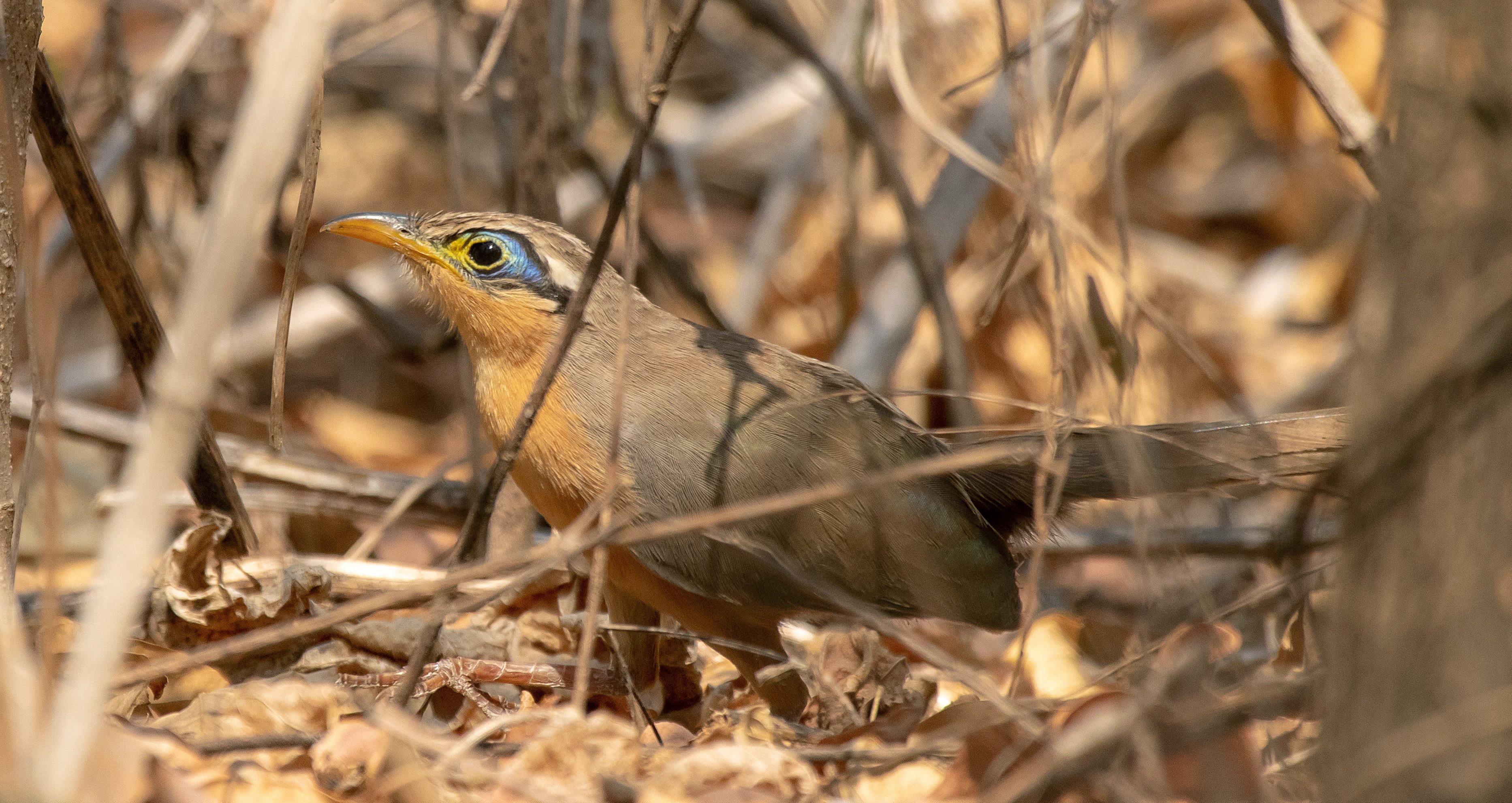
MAIN TOUR: 20 February-4 March 2025
Day 1
FLY TO GUATEMALA CITY AND TRANSFER TO ANTIGUA
Our birdwatching tour to Guatemala begins with a morning departure for Guatemala City. Arriving in the late afternoon/early evening, we will be met by our Guatemalan local guide and drive west (for about an hour) to Antigua, where we stay for two nights.
This small colonial city is situated 1,500m (c.5,000 feet) above sea level and is ringed by inactive volcanoes. After a delicious evening meal at the hotel, we will get an early night to be ready for an early start the following morning. Night in Antigua
Day 2
FINCA EL PILAR
Making an early start, we have an exciting day’s birding in store at Finca El Pilar, a splendid private estate within 20 minutes of our hotel. Ranging from 1,600m-2,400m (5,250-7,870ft) above sea level, El Pilar protects a superb variety of bird-rich habitats from dry forest lower down, up through moist pine-oak woodland to cloud forest at higher elevations.
We plan to head directly to the upper elevations as the clearing near the top can be alive first thing with Grey Silky-flycatchers, Rufous-collared Thrushes, Black-headed Siskins and much more, although we may not linger for too long as the montane oak forests host even more species!
The beautiful Mountain Trogon will be high on our list of specialities to look for, as will the equally appealing and difficult to find Hooded Grosbeak. Other good birds to watch for include the always elusive Singing Quail, Black-capped Swallow, Bushy-crested Jay, Bar-winged and Black-vented Orioles and Flame-coloured Tanager.
Breakfast will be at a lovely place overlooking Antigua, before we drop down to bird at lower levels and to enjoy the ceaseless activity at El Pilar's busy hummingbird feeders. Located at the start of the trail, the feeders are notable for five key species: Rufous Sabrewing (a species that is endemic to the Pacific Slope mountains of Guatemala, Chiapas (Mexico) and El Salvador) and the recently-split Rivoli’s Hummingbird (formerly Magnificent), plus Berylline, Azure-crowned and Blue-tailed Hummingbirds. The regionally endemic Green-throated Mountaingem is also frequently seen along with White-eared Hummingbird, Mexican Violetear and the impressive Violet Sabrewing.
All in all, an exciting and bird-filled day is assured before we head back down to our hotel in Antigua for dinner. Night in Antigua
DAY 3
RINCÓN SUIZO AND ONWARDS TO HUEHUETENANGO
Leaving Antigua, we plan to travel northwest for about an hour to Tecpán. Just to the north of the city, Rincón Suizo is a restaurant along the Panamerican Highway, at an elevation of 2,500m (8,200 feet) and our first port of call today. We spend the morning birding near here, after first enjoying breakfast at the restaurant.
Nestling behind the restaurant is a small mountain forest reserve of pine, cypress, oak and alder. Less exotic and exuberant than the humid cloud forests on the Guatemalan Atlantic Slope, the forest at Rincón Suizo may remind visitors of North American or European woodlands, but the birds are very different! Trails offer access to a site that is home to a number of sought-after northern Central American highland endemics.
High on the list is the fantastic Pink-headed Warbler but other specialities include Green-throated Mountaingem, Blue-throated Motmot and Rufous-browed Wren. Like many tropical forests, at times the birding can seem quiet but sooner or later we will come across one of the mobile mixed feeding flocks. Joining the resident forest species can be an assortment of Nearctic migrants including Townsend's, Wilson's, Black-and-white, Hermit and Red-faced Warblers, along with the resident Slate-throated Redstart, Hutton's Vireo and Crescent-chested and Olive Warblers.
As we search eagerly through the restless flocks for the much-wanted Pink-headed Warbler, the likes of Spot-crowned Woodcreeper and Brown Creeper are likely to come our way, the latter a southern form that may yet be split.
With careful searching, we might also discover a colourful Chestnut-sided Shrike-Vireo as well as Bushtits passing through the forest, sometimes in flocks of more than 30 birds.
Whilst walking the trails, we may find a Tufted Flycatcher and these can sometimes be joined by Pine, Buff-breasted and Hammond’s Flycatchers, along with Greater Pewee and the local races of Plumbeous Vireo and Mountain Trogon. Lowering our gaze to the understorey, we may detect a furtive Ruddy-capped Nightingale-Thrush, the bright and rusty cheeked Golden-browed Warbler or a smart Chestnut-capped Brushfinch.
Amongst a fine array of forest hummingbirds, White-eared Hummingbird is frequently found and these can be joined by Amethyst-throated and Rivoli’s, while the stunning Garnet-throated Hummingbird also occurs. In open areas, we will seek Yellow-eyed Junco, Spotted Towhee and the endemic and strikingly bibbed Rufous-collared Thrush. If we are very lucky, and with our eyes to the skies, we may spot the elusive White-breasted Hawk, soaring overhead with the local race of Red-tailed Hawk.
Reluctantly tearing ourselves away from Rincón Suizo, we continue north-westwards towards our destination for the evening, Ruinas Resort in the provincial town of Huehuetenango. We will pause along the way to enjoy lunch at a local restaurant and make selective birding stops as we travel Night at Ruinas Resort.
DAY 4
PARQUE TODOS SANTOS
We plan to make an early start to visit Parque Todos Santos where our main goal is to find Goldman's Warbler. Previously treated as a race of Yellow-rumped Warbler, this distinctive bird is now widely regarded as a full species and has a very localised range in southern Chiapas (Mexico) and Western Guatemala.
We will be birding on a tableland in the Sierra Los Cuchumatanes which thousands of years ago was shaped by glaciers and will explore areas of open grassland and juniper and pine woodlands where the warbler can be found.
There are also a number of other species here which are difficult to find in other parts of Guatemala and these include Unspotted Saw-whet Owl, Flammulated Owl, Ocellated Quail and Broad-tailed Hummingbird with other possibilities including White-eared Hummingbird, Magnificent Hummingbird, Rufous-collared Robin, Yellow-eyed Junco, Spotted Towhee and Steller's Jay.
If time allows, there may be an opportunity to explore an area of humid fir and broadleaf forest where we have further chances to see Pink-headed Warbler as well as White-breasted Hawk, Rufous-browed Wren and Amethyst-throated Hummingbird.
During the afternoon, we will leave for Zunil Quetzaltenango and a one night stay at Las Cumbres, an enchanting ‘Posada Rural’. We may make a late afternoon visit to Fuentes Georginas, a public hot spring within an area of cloud forest, before continuing on to our comfortable hotel. Night Las Cumbres
DAYS 5 - 6
FUENTES GEORGINAS AND LOS TARRALES
With the endangered Horned Guan firmly in our sights, we will set off early leaving the hotel before sunrise (06:30am) to travel the short distance back west to Fuentes Georginas. This hot spring resort is not only popular with the locals, but the pristine cloudforest here is also well preserved and offers our first real chance to find the near-mythical Horned Guan. Although the chances of seeing one are perhaps lower than in the San Pedro area later in our tour, this spot certainly turned up trumps for our 2019 group, so it is well worth a look!
Even if we don’t manage to find the guan, there are a host of cloudforest birds to enjoy with many of them easily seen around the car park or after a short walk along the road. Highland Guan, Wine-throated, Amethyst-throated and Garnet-throated Hummingbirds, Mexican Violetear, Blue-throated Motmot and Ruddy-capped Nightingale-Thrush are among mouth-watering possibilities, along with a fine collection of warblers including Olive, Crescent-chested, Hermit, Townsend’s and more opportunities for Pink-headed.
Los Tarrales is a birder's paradise - if you had to pick just one place to bird in Guatemala, this would be it! More than 350 bird species have been recorded from this superb private protected area, where primary rainforest and cloudforest is interspersed with coffee and flower plantations on the southern slope of the Atitlán volcano.
The economy of this enlightened finca is based on shade grown coffee and ecotourism. While it is important to support and encourage that, one of the great things about staying at Los Tarrales is that this place is very 'authentic'. The guest accommodation is rather modest, although clean and very comfortable, and you will see the families working on the finca on their way to the coffee plantations. The homemade cooking is among the best we will enjoy anywhere in Guatemala and the scenery is spectacular - you can see the Atitlan Volcano from the lodge... There are also birds everywhere and it is not unusual to see 100 species here before lunch!
At Los Tarrales, we will bird from a number of accessible trails that run through the excellent forest, seeking out species that are restricted in Guatemala to the Pacific Slope. Pacific, Orange-chinned and Orange-fronted Parakeets, Rufous Sabrewing, Blue-tailed Hummingbird and the cobalt-backed Long-tailed Manakin will all be high on the list and we have a great chance of seeing the rare and range-restricted Azure-rumped Tanager. During our stay, we will also need to check the feeders for White-bellied Chachalacas.
The tricky Rufous-breasted Spinetail and Spot-breasted Wren will no doubt occupy some of our time, while at a small plantation, a pair of stunning red-billed Blue-throated Sapphires sometimes set up territory with the male often calling and performing from small sticks. As the day draws on, the likes of Lineated Woodpecker, Collared Aracari, Ivory-billed Woodcreeper and White-winged Tanager will hopefully come our way and we should also see Yellow-naped Amazon.
On one morning, we are likely to leave our lodgings before sunrise so as to be at the right spot in the half-light of pre-dawn to await the Highland Guans. As the light slowly improves, we should be treated to better views before they slope off to be replaced by Crested Guans and White-bellied Chachalacas. Nearby, we will search for the tricky Tody Motmot and with patience will hope for ‘scope views of this wonderful little bird! Concealed within the local trees, our guides might also find a day-roosting Mottled Owl before we head back to the finca for a well-deserved breakfast.
Replete, the rest of our morning will be spent looking for the many other avian specialities Los Tarrales has to offer. It is an immense property, one that encompasses a large portion of the Atitlan Volcano from the lower grounds around the base, all the way to the top.
There should be a great assortment of hummingbirds with Green-breasted Mango, White-bellied Emerald, Long-billed Starthroat and Emerald-chinned Hummingbird among many delights in store. The brilliant orange Spot-breasted Oriole is often about, as we try for the rather less showy White-faced and Ruddy Quail-Doves, Rufous-breasted Spinetail and the delectable Prevost's Ground Sparrow. As the day warms, the skies above Los Tarrales are home to large raptors such as Black and Ornate Hawk-Eagles and the impressive King Vulture.
After lunch (and a short siesta for those that want it), we may explore a different trail, hoping for views of the shy White-throated Thrush and keeping a sharp eye out for the diminutive Northern Bentbill and Worm-eating Warbler.
Returning before dusk, we can again try for Highland Guan and, as we wait for them to appear, groups of Yellow-naped Amazons may pass over on their way to their roost and neat White-eared Ground Sparrows can be picked out on the ground.
Night birds at Los Tarreles include the stunning Black-and-white and Mottled Owls, and there is often a Common Pauraque about, hawking for moths. The strange Northern Potoo sometimes appears and can give great views, while other nocturnal creatures we can try spotlighting for after dark include Kinkajou and several interesting amphibians. Two nights Los Tarrales
DAYS 7 - 8
LAKE ATITLÁN AND THE SAN PEDRO VOLCANO
We will enjoy some final early morning birding at Los Tarrales before reluctantly leaving for the short transfer north to Santiago Atitlán, where we will spend the next two nights at a hotel within a five-minute walk of the shore of Lake Atitlán which is ringed by volcanoes and often described as the world's most beautiful lake.
We will enjoy a little birding beside the lake during our stay, hoping to catch up with the elegant Slender Sheartail and visit one or two sheltered bays around the shore, which can be good for waterbirds including a good variety of herons and egrets, Sora, Purple Gallinule, Blue-winged Teal and Lesser Scaup.
The cloudforests that cloak the immense Atitlán and San Pedro volcanoes which rise up from the lake are the best place to look for Horned Guan and if we haven’t been lucky before we will make a special effort to find this spectacular bird first thing on our second morning.
The rare and endangered Horned Guan is a relic of the Cracidae family that persists today only in small fragments of its previous range with its sole habitat being cloudforests above 1,650 metres (5,400ft). As big as a turkey, adult males have a 3cm scarlet ‘horn’ which projects like a ‘Tom and Jerry cartoon bump’ straight up from the top of the head!
Horned Guans are active first thing in the morning so a very early start (optional for those who wish to take part) will be essential on Day 8 if we are to have any real chance of seeing one. Our adventure begins with a 20-minute boat trip across the emerald-and-blue waters of Lake Atitlán, from Santiago Atitlán to San Pedro La Laguna (it being much quicker to take a boat than to drive around the shore). The boat trip may only be short, but it is both beautiful and scenic for the caldera lake is surrounded by dramatic volcanoes which soar to 3,000m (9,800ft).
Birders have two bites of the Horned Guan cherry at San Pedro: one at a relatively easy 'new site' discovered nearby whilst the other is at a traditional area high on the slopes on Volcan San Pedro. As luck would have it, the 'new site' has recently proved to be the best place to find the guan and has the added attraction that the walk to this area is both shorter (about an hour) and much less arduous than the very steep hike required to reach the 'old site' on San Pedro.
After (hopefully!) having seen the Horned Guan at the new site, we have a chance to pick up a few more of the volcano's special birds with Wine-throated Hummingbird, the diminutive and highly localised Belted Flycatcher, Rufous-browed Wren and perhaps even the orange-bellied Elegant Euphonia amongst the possibilities.
As we descend again, we have a great opportunity to find the tricky Blue-and-white Mockingbird (looking not unlike an outsize Black-throated Blue Warbler) in drier areas lower down before catching the boat back across Lake Atitlán and relaxing after a well-deserved lunch back at our hotel.
For anyone who doesn't wish to participate in the early morning excursion for the guan, our hotel is located close by the shore of Lake Atitlán, with the most amazing views you can imagine and a wonderful diversity of birds to be found on the hotel grounds. Two nights at Hotel Bambu, Santiago Atitlan
DAY 9
LAKE ATITLÁN TO MOTAGUA
Departing Santiago and the Lake Atitlán region after breakfast, we travel east, fringing the outskirts of Guatemala City on our way to the Motagua Valley. We plan to break our journey with a stop for lunch at Guatemala City and also to visit a local reserve in search of Buffy-crowned Wood Partridge and other highland specialties.
Continuing east, we will aim to arrive at our next hotel, in the hot and dry Motagua Valley around 5.00pm with time to enjoy a little late afternoon birding around the hotel. The habitat here will be totally new to us and so too will be the birds! Night Hotel Camino Largo
DAYS 10 – 11
MOTAGUA VALLEY, RIO ESCONDIDO RESERVE (GOLDEN-CHEEKED WARBLER) AND BIOTOPO DEL QUETZAL
The central valley of the Motagua River is the hottest and driest region of Guatemala and is actually the driest area in Central America. Located on the leeward side of the Sierra de las Minas Mountains, very little precipitation reaches the Motagua Valley with just enough rain falling to allow sparse thorn scrub and dry forest with a 3-5m tall canopy. Characteristic plants include spiny shrubs, cacti (including tall columns), acacias and Guayacan trees.
Making the most of the lower temperatures first thing, we will set off early this morning to visit the dry forest reserve at Estación Biologica Heloderma. As the sun begins to rise and bird activity increases, we will await the arrival our first feeding flock. White-lored Gnatcatchers, Northern Beardless Tyrannulets, Nutting’s Flycatchers, Streak-backed Orioles and the gorgeous Varied Bunting are among likely species.
Taking tracks down by the river, we may spot a fleet-footed Lesser Roadrunner darting across the road, while the more verdant riverine forests hold Squirrel Cuckoo, Cinnamon Hummingbird and a good selection of northern migrants, such as American Redstart and Northern Parula.
Of the many bird species that make Motagua's thorn scrub and dry forest their home, we shall be watching for Spot-bellied Bobwhite, Russet-crowned Motmot, Lesser Ground Cuckoo, Plain-capped Starthroat and Stripe-headed Sparrow. The handsome Turquoise-browed Motmot is one of the most conspicuous valley residents and we also hope to find Altamira and Spot-breasted Orioles, White-throated Magpie-Jay and Rufous-naped Wren. Checking the skies might reward us with a Black Hawk-Eagle or a passing White-fronted Amazon.
From here, we travel on to the Reserva Natural Privada Rio Escondido, home to the rare and endangered Golden-cheeked Warbler which overwinters here and migrates north to Texas where it breeds. We will enjoy lunch near the reserve before travelling the short distance (12km) to our next hotel, Ram Tzul Lodge, on the northeast slope of the Biotopo del Quetzal.
Ram Tzul, where we stay for two nights, is a rustic eco-lodge that was set up to help fund and preserve the threatened habitat of Guatemala's National Bird - the spectacular Resplendent Quetzal. The lodge enjoys panoramic views of pristine cloud forest, and the grounds are fantastic for birds, with lots of warblers and tanagers and not far away is the much smaller but equally productive Ranchitos del Quetzal Reserve, which we may also visit. Two nights Ram Tzul EcoLodge
DAY 12
BIOTOPO DEL QUETZAL, RETURN TO GUATEMALA CITY AND FLY LONDON
It is our final day in Guatemala so we will start early to enjoy some further birding in the Biotopo del Quetzal, when bird activity is at its peak.
La Reserva del Quetzal, in the Biotopo del Quetzal, protects a vast swathe of cloud forest. Only a small section of this 1000-hectare reserve is open to visitors, with access via two trails that begin at the Visitor Centre and follow a circuit through the forest.
The reserve offers good opportunities to see birds of mid-elevation cloud forest, but our main focus will be on finding the smart Azure-hooded Jay, Chesnut-headed Oropendola and of course, the exquisite Resplendent Quetzal. Though it is indeed spectacular with its long tail and bright emerald-green colouration, this species can also be unexpectedly elusive! As we search for it, we should enjoy a fine supporting cast which could include Scaly-throated Foliage-gleaner, Spotted and Black-headed Nightingale-Thrushes, Tawny-throated Leaftosser, Slate-coloured Solitaire, Common Bush Tanager and Blue-crowned Chlorophonia. We also have another chance here of seeing the lovely Golden-cheeked Warbler.
Leaving La Reserva del Quetzal, sadly we must return to the hotel to collect our bags and depart for Guatemala City. We will stop along the way to enjoy a farewell lunch, before continuing on to the airport for an overnight flight back to the UK.
DAY 13
ARRIVE LONDON
Afternoon arrival at Madrid and onward connection to London, where our birdwatching tour to Guatemala concludes late this afternoon.
EXTENSION -TIKAL NATIONAL PARK AND LAS GUACAMAYAS BIOLOGICAL STATION: 3-9 March 2025
Our extension visits the lowlands of Northern Guatemala and as well as looking for a very different suite of birds to the main tour, we will also devote some of our time to visiting the world-famous archaeological site at Tikal.
DAY 12
TRANSFER TO FLORES
After a final farewell to those returning home, we plan to take an early evening flight from Guatemala City to the small town of Flores which should take approximately one hour. It is then just a short transfer to our comfortable hotel which is located on the banks of a nearby lake. Night Flores
DAY 13
LAS GUACAMAYAS BIOLOGICAL STATION
After breakfast, we will depart for Las Guacamayas Biological Station which sits on the edge of the vast Mayan Biosphere Reserve. The journey should take about three hours (allowing for some short birding stops enroute) and we are likely to see a range of open country and waterbirds as we travel.
On arrival at the small community of Paso Caballos, we will use a boat for the transfer (c.20 minutes) across the San Pedro River and on to the biological station. The buildings are surrounded by pristine forest and it is difficult to spot these until you reach the deck by boat.
The birding in the immediate vicinity is fantastic and there are several hummingbird feeders which we will certainly want to spend time watching with the possibilities including White-necked Jacobin, Long-billed Hermit, Stripe-throated Hermit, Purple-crowned Fairy, Green-breasted Mango, Wedge-tailed Sabrewing and Scaly-breasted Hummingbird.
Approximately 340 species of birds have been recorded in this region (about 50% of the Guatemalan list) and after lunch and once the temperature has cooled somewhat, we will begin our exploration of the area.
One of the places we plan to visit is an observation tower which is not far from our accommodation, and which overlooks the forest and nearby marshes. We may well head there as the sun drops towards the horizon as it is a perfect place to end the day whilst enjoying a sundowner…..
After dark, there will be a further (optional) excursion which is likely to be out on the river which will give us a very different perspective of the wildlife of the area. One of the species we hope to find is Morelet’s Crocodile which is only found in limited parts of Mexico, Belize and Guatemala, however, the diversity of nocturnal species makes this one of the most exciting places for night birding anywhere in the country with a number of special and highly localised species to look for.
Amongst those we hope to find are Short-tailed Nighthawk, Yucatan Poorwill, Yucatan Nightjar and Spot-tailed Nightjar. Indeed, this area is considered the only reliable site for the latter species in Guatemala. With other possibilities including Common Pauraque, Mottled Owl, Black-and-White Owl and Northern Potoo, it promises to be an extremely exciting evening with plenty to look for. Night Las Guacamayas Biological Station.
DAY 14
LAS GUACAMAYAS BIOLOGICAL STATION AND EL PERU ARCHAEOLOGICAL SITE
After an early breakfast, we will board a boat to begin our exploration of the rich area around the biological station. The archaeological site of El Peru is only a relatively short distance away and this is the most important nesting area for Scarlet Macaw in Guatemala and getting some good views of these large parrots will be one of our major priorities.
There are plenty of other great birds to look for including the beautiful Agami Heron and whilst this low-density heron can never be guaranteed, this area is particularly good for it. We will also hope to find the secretive Sungrebe and another possibility is Yucatan Woodpecker, a species which is very rare and localised in Guatemala.
Other birds we may find include Ocellated Turkey, Ornate Hawk Eagle and Rose-throated Tanager, the latter being another species which is endemic to the Yucatan Peninsula. Green-backed Sparrow is also comparatively localised and we will hope to find this along with the appropriately named Lovely Cotinga.
We plan to return to the lodge for lunch and will then spend the afternoon continuing our exploration of the nearby trails. Some of the birds we could find include White-bellied Emerald, White-crowned Parrot, Pale-billed Woodpecker, Tody Motmot, Lesson’s Motmot, Gartered Trogon and White-bellied Wren. Second night Las Guacamayas Biological Station
DAY 15
LAS GUACAMAYAS BIOLOGICAL STATION TO TIKAL NATIONAL PARK
We will enjoy some final early morning birding along the banks of the San Pedro River which is a matter of only one hundred metres or so from the biological station and will then set off for the final highlight of our holiday, a visit to the extraordinary Tikal National Park.
We are likely to make a short stop at El Remate where the possibilities include Canivet’s Emerald, Band-backed Wren and Black-headed Saltator, however our priority will be to reach Tikal (the journey from the Guacamayas is about 80 miles and should take about 3.5 hours) for a sunset tour at this world-famous location.
The area is a UNESCO World Heritage Site and there are thousands of ruined structures across the entire complex and this is without question the most important site to survive from the Mayan civilisation, indeed some would argue it is one of the most important archaeological sites in the Americas. The area is believed to have been inhabited from the 6th century BC until the 10th century AD and includes some remarkable palaces and temples.
We should have some time to begin our exploration of the area before transferring to our nearby comfortable hotel. Night Jungle Lodge, Tikal
DAY 16
TIKAL NATIONAL PARK
We have a full day to explore the Tikal National Park which is the nucleus of the Maya Biosphere Reserve. With many of the monuments located in the midst of luxuriant forest, this gives us a fantastic opportunity to combine birdwatching with enjoying the amazing archaeology.
A host of birds are possible here with the possibilities including Ocellated Turkey, Great Curassow, White-fronted Parrot, Orange-breasted Falcon, Keel-billed Toucan, Yucatan Jay, Black Catbird, Rose-throated Tanager, Chestnut-coloured Woodpecker, White-bellied Wren and Montezuma Oropendola. However, when we are birding in such extraordinary surroundings, we will undoubtedly want to devote some of our time to marveling at the extraordinary structures the Mayan peoples constructed. Second night Jungle Lodge, Tikal.
DAY 17
TIKAL TO GUATEMALA CITY
We will enjoy some final early morning birding around Tikal before reluctantly returning to Flores (approximately one hour) for a lunchtime flight back to Guatemala City. We should be back at the capital by early afternoon with plenty of time to check-in for our international flights back to the UK.
DAY 18
ARRIVE LONDON
Afternoon arrival at Madrid and onward connection to London, where our birdwatching tour to Guatemala concludes late this afternoon.
The extension costs:
2025: £1,995 per person (twin sharing) with a single supplement of £350
Extension includes:
- Limosa Tour Leader (subject to a minimum of four clients)
- Local specialist birding guide
- Five nights’ accommodation in ensuite rooms
- All meals from dinner on day 12 to lunch on day 17
- Internal return flight between Guatemala City and Flores
- Ground transportation including boat transfers and trips at the biological station
- Reserve and Park entry fees, all tour-based tips (including drivers, local guides) and taxes
Not included: insurance, drinks and other items of a personal nature.
Please note: should less than four clients book the extension, it can be operated without the Limosa leader and you will be accompanied by the specialist local bird guide provided by our ground agent.
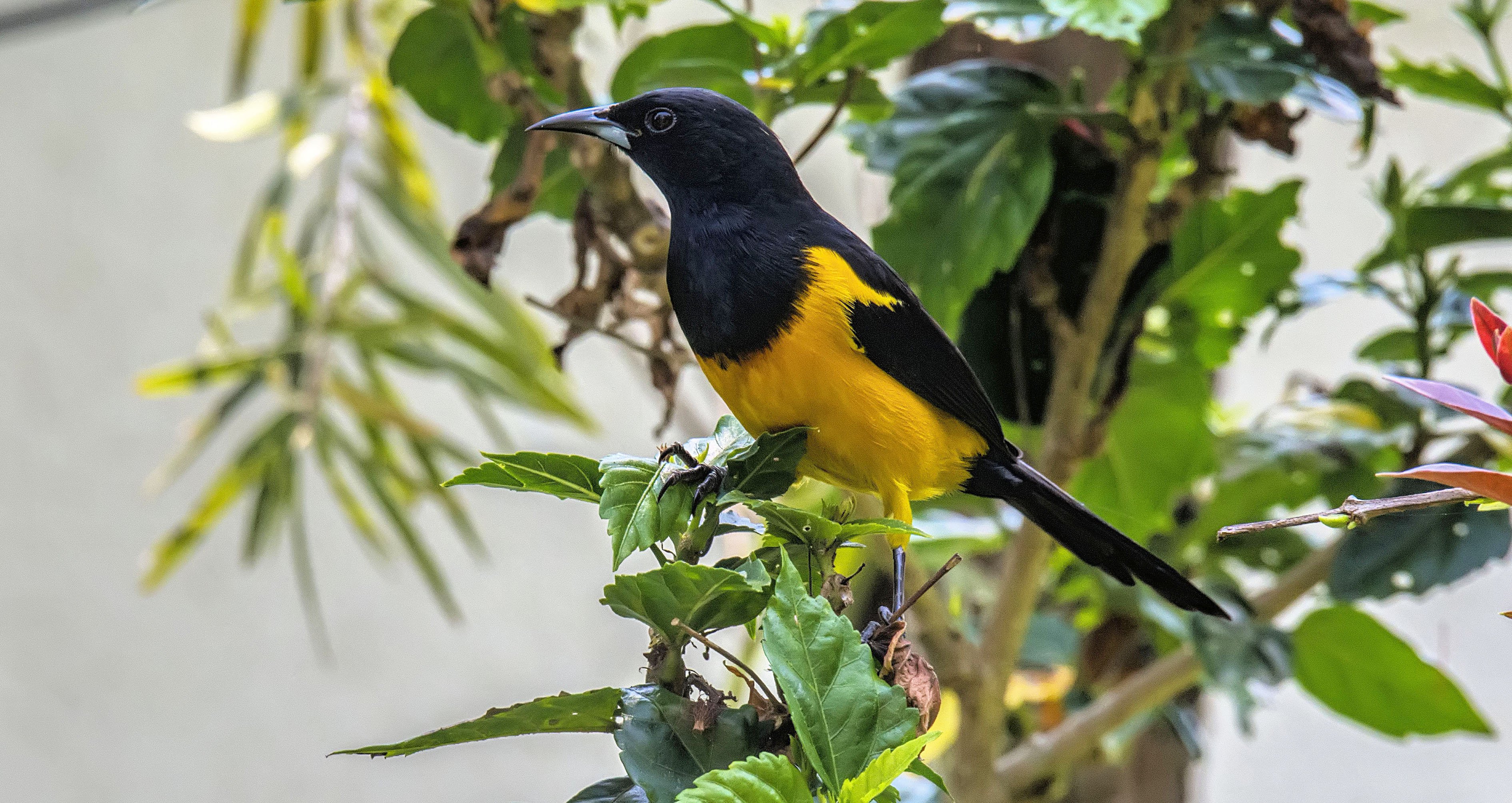
WHAT TO EXPECT
We will be making early starts on this tour, which is the norm for birding tours in the tropics where the daylight hours are relatively short and where bird activity is at its peak early and late in the day. For certain key species, it is essential to be out in the field at first light so we can hear the birds singing and calling as the day starts up and in some instances, this may be our only chance to find some species, so we will naturally want to make the most of this opportunity. During February, sunrise in Guatemala is around 6.15am and sunset around 6.15pm.
Much of our birding in Guatemala will be in tropical forest. Very little of the country is flat so we will mostly be walking on hill trails, birding from tracks and trails with occasional steeper sections. Where possible, we aim to drive uphill and bird as we walk back down. It will be warm to hot, humid at times (though often cooler and more refreshing at altitude), and we may be on our feet for up to several hours at a stretch watching for birds so some participants may find it handy to carry a lightweight collapsible stool.
Overall, the tour is not a strenuous one (see also Walking, below), but you should be prepared for early starts in order to enjoy the best of the day's birding before the heat and humidity builds and activity starts to wane. After a lull during the hot middle part of the day (there will be afternoon rests after lunch on some days), the birding tends to pick up again from mid-afternoon and, though the daylight hours are relatively short in the tropics, you should be ready for some long field days as we are likely to be out until near dusk on more or less a daily basis.
Our guides will be able to advise you locally about the day's events and if you prefer to opt out of a particular activity or walk, please don’t be afraid to ask them.
Guatemala enjoys a tropical to temperate climate, according to altitude. Our February tours run during Guatemala’s ‘dry season’, but note rainfall can (and does!) occur year-round in the mountains and rainforests! It can be cool and misty in the mountains and cloud forest, especially early in the day. It is generally hotter and sunnier on the Pacific Slope (Los Tarrales) and in the Caribbean Lowlands (Motagua Valley), with temperatures typically in the range of 10-30C (50-86F).
Good to excellent photographic opportunities in more open habitats, especially at the feeders around the lodges - birds, wildlife and some splendid scenic shots. Trickier in the forest due to low light levels.
BIRDS
240-280 species on the main tour
MAMMALS
5-10 species. Forest mammals can be tricky but possibilities include White-tailed Deer, Red Brocket Deer, Collared Peccary, Central American Agouti, Kinkajou and the enigmatic Cacomistle, a poorly known relative of the Raccoon. Jaguar and Puma still roam the most remote areas but are most unlikely to be seen.
ACCOMMODATION
On the main tour we will have 11 nights accommodation in Guatemala, staying at a varied selection of comfortable, characterful and conveniently located hotels, lodges and fincas (private estates) described above. All rooms have private facilities.
There will be five additional nights on the extension with all of these in comfortable accommodation with ensuite facilities.
MEALS
All main meals (and with drinking water provided during the day) are included in the tour price, commencing with dinner on arrival in Guatemala on Day 1 and concluding with lunch there on Day 11.
For those going on the extension, meals are included until lunch on Day 17.
Food is good to excellent throughout, appetising and very tasty. Most restaurants offer a good selection of traditional Guatemalan dishes such as Pepian (meat, vegetable and spice stew, the national dish of Guatemala), Jocon (chicken in tomatillo sauce), Guatemalan enchiladas and Kaq’ik (Guatemalan spicy turkey broth) which are all served with tortillas.
WALKING
Our main tour concentrates mainly on the Central Highlands to the west of Guatemala City. Most of our walks here are short and easy (moderate for Horned Guan), but please note that Guatemala is a mountainous country in places so we will often be walking up or down trails. You should expect some trails to be steeper in parts but we take all our walks slowly, with frequent stops to rest and bird. Walking poles and/or lightweight collapsible stools can be handy.
The walk to look for Horned Guan at San Pedro Volcano (Day 8) is more strenuous. We will depart very early and will be visiting Cerro Paquisis, the 'new site' for this species (the walk up to which is relatively easy compared to the relentless three-hour slog uphill to the 'old site', which we will not be attempting on our tour).
The walk to Cerro Paquisis takes an hour or so along a path that is well maintained by local foresters, but with lots of steps. We will take this at our own pace, pausing to rest as often as necessary. At the top, there is a plateau where the cloud forest begins. This limit between the montane forest and the cloud forest is very birdy with Wine-throated Hummingbird among specialities to watch for and we will regroup here before seeking the guan.
On the extension, we will be in the lowlands of Northern Guatemala for five days. At the biological station (2 nights), we will use boats on occasions but there will also be some gentle walks.
At Tikal, we will combine birdwatching with exploring what is one of the most important archaeological sites in the Americas but again all walks will be at a gentle pace.
Though it is the 'dry season' rainforest trails can nonetheless be uneven, muddy and/or slippery underfoot at times, so sturdy waterproof walking shoes or lightweight boots with good grip are recommended for this tour.
Maximum elevation this tour: 3,000m.
TRAVEL
Despite the end of pandemic restrictions, we have taken the decision to continue to price our holidays as excluding international flights.
To keep the process as simple as possible, we are working very closely with a dedicated agent at Travel Counsellors, Sacha Barbato, who is essentially now our “in house” flight consultant.
Sacha will be able to advise you which flights we are recommending for each holiday, and he will be able to book these for you.
This will also sometimes give you the option to travel from a regional airport if you prefer.
Ground Transport We travel by comfortable minibus with air-conditioning and experienced local driver.
At Los Tarrales, an early start is essential in order to be at the right spot at first light to look for Highland Guan. We plan to leave the lodge about 30 minutes before sunrise and use two 4x4 vehicles to cover the nearly 2 miles (15-20 mins) drive into the reserve. After hopefully seeing the guans, we will drive back down again, this time stopping along the way to enjoy some more birding.
A very early start is essential for the (optional) Horned Guan trip at San Pedro Volcano, which begins with a 20-minute boat ride across Lake Atitlan (from Santiago Atitlan to San Pedro La Laguna). Here, modified pick-up trucks will be waiting to transfer us from the lake to the start of the volcano trail. It is a fun ride since the trucks have space to sit or stand up (there is a rail to hold and seats) while enjoying the beautiful landscape. Note that it can feel cold early in the morning, so layer up with warm clothing that can be peeled off as the day begins to warm.
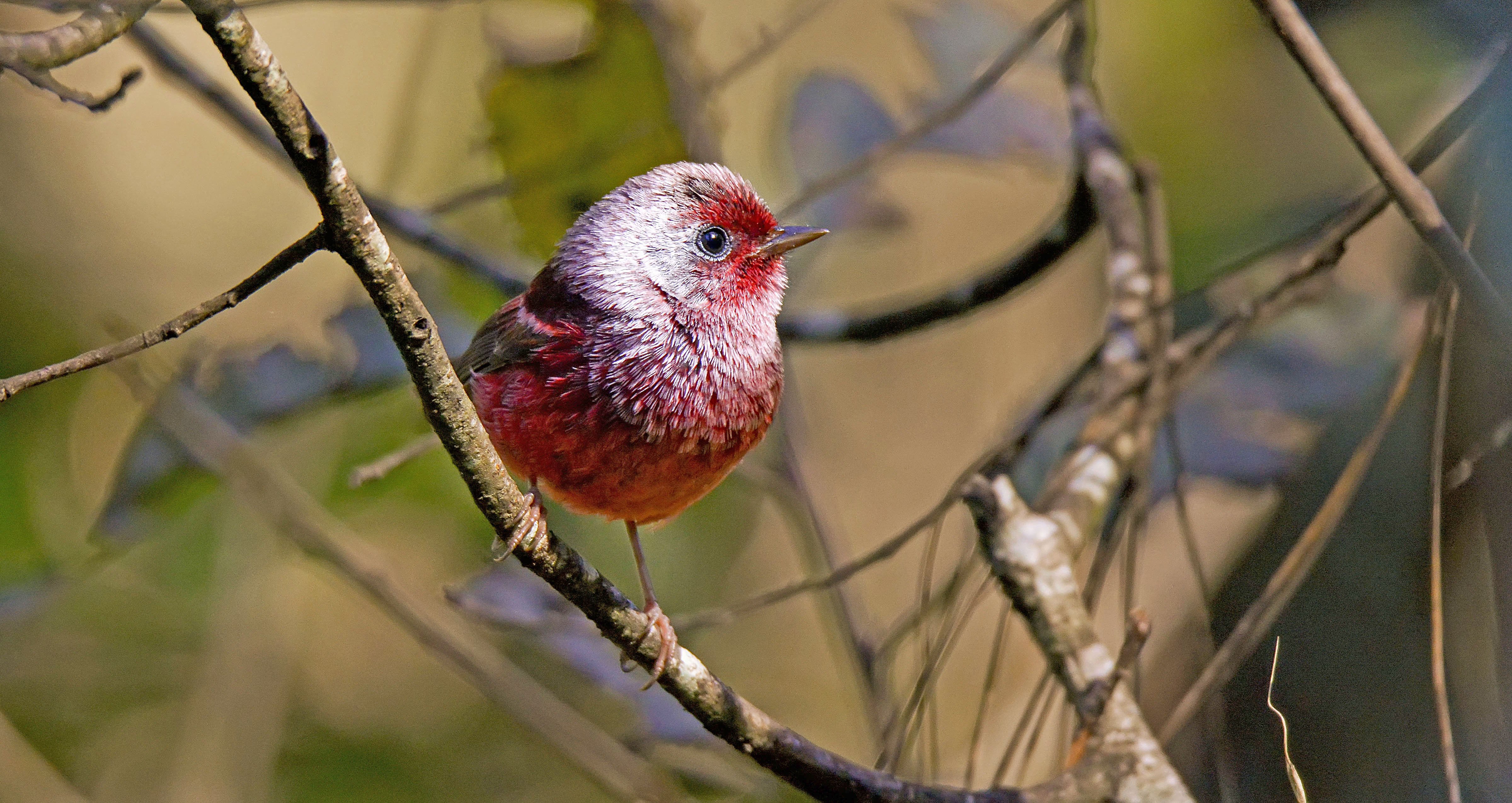
Tour Gallery
View a gallery of images for this tour below, click on an image to view as full size with caption
